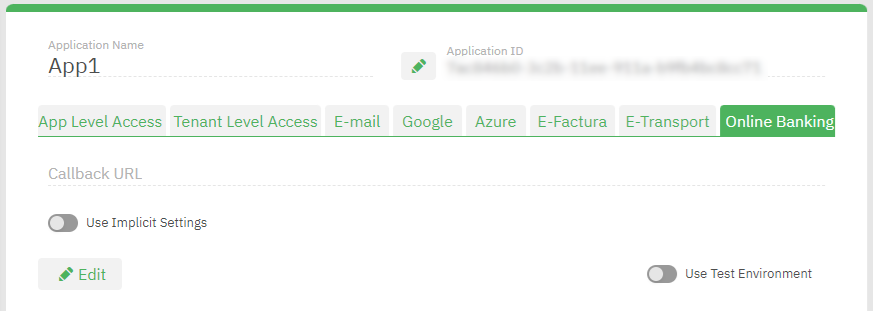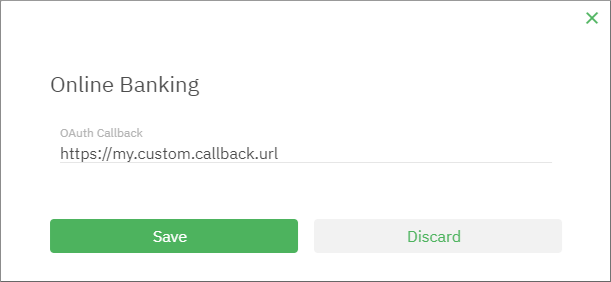Configure online banking
If you intend to use the Online Banking Service, you must configure the following settings in your application:
- whether your application should use a test or a production environment for online banking
- whether your application should use implicit or custom online banking settings.
Configure the environment
By default, the online banking environment of a new application is not defined, which means that the application uses the production environment.
To configure your application to make calls to the test online banking environment instead of production:
-
Sign in to the SBS Console.
-
In the left-hand side navigation menu, click Applications.
-
Click the application for which you would like to configure the online banking environment.
-
Click the Online Banking tab.
-
Click Use Test Environment to switch to the test environment.

-
In the confirmation dialog box that pops up, type TEST and click Agree to confirm.
GraphQL
To change the online banking environment from GraphQL:
- Run the
updateAppmutation of the Account API and set your application’sonlineBankingUseTestEnvironmentattribute to true.
The example GraphQL query below sets the online banking environment to test. Make sure to replace YOUR_APPLICATION_ID below with your actual application ID.
mutation updateApp($id:ID!,$input:UpdateAppInput!) {
updateApp(id:$id, input:$input) {
id
name
onlineBankingUseTestEnvironment
}
}
{
"id": "YOUR_APPLICATION_ID",
"input": {
"onlineBankingUseTestEnvironment": true
}
}
When your application is ready for production, run the same mutation as above, while setting the onlineBankingUseTestEnvironment attribute to false.
Configure the online banking settings
By default, the online banking settings of an application are not defined. Before making any online banking calls, you must decide whether your application should use implicit or custom defined settings.
Currently, the only custom setting you can define is the OAuth 2.0 callback URL. When implicit settings are enabled, your application’s OAuth 2.0 callback URL is as provided by the API and cannot be changed. Your application’s users will be redirected to this URL after completing the OAuth 2.0 authorization process.
To configure your application to use pre-configured (implicit) online banking settings:
-
Sign in to the SBS Console.
-
In the left-hand side navigation menu, click Applications.
-
Click the application for which you would like to configure the online banking settings.
-
Click the Online Banking tab.
-
Click Use Implicit Settings to enable this setting.

To configure your application to use a custom callback URL for online banking:
-
Make sure that the Use Implicit Settings setting is disabled (greyed out).
-
Click Edit. A dialog box appears.
-
Enter your custom callback URL in the dialog box and click Save.

GraphQL
To enable the online banking implicit settings from GraphQL:
- Run the
updateAppmutation of the Account API and set your application’sonlineBankingUseImplicitSettingsattribute to true, for example:
mutation updateApp($id:ID!,$input:UpdateAppInput!) {
updateApp(id:$id, input:$input) {
id
name
onlineBankingUseImplicitSettings
}
}
{
"id": "YOUR_APPLICATION_ID",
"input": {
"onlineBankingUseImplicitSettings": true
}
}
To use a custom OAuth 2.0 callback URL for your application’s online banking, disable the implicit settings, and define a custom URL, as shown in the example below:
mutation updateApp($id:ID!,$input:UpdateAppInput!) {
updateApp(id:$id, input:$input) {
id
name
onlineBankingUseImplicitSettings
onlineBankingSettings { oauthCallback }
}
}
{
"id": "YOUR_APPLICATION_ID",
"input": {
"onlineBankingUseImplicitSettings": false,
"onlineBankingSettings": {
"oauthCallback": "https://example.org"
}
}
}